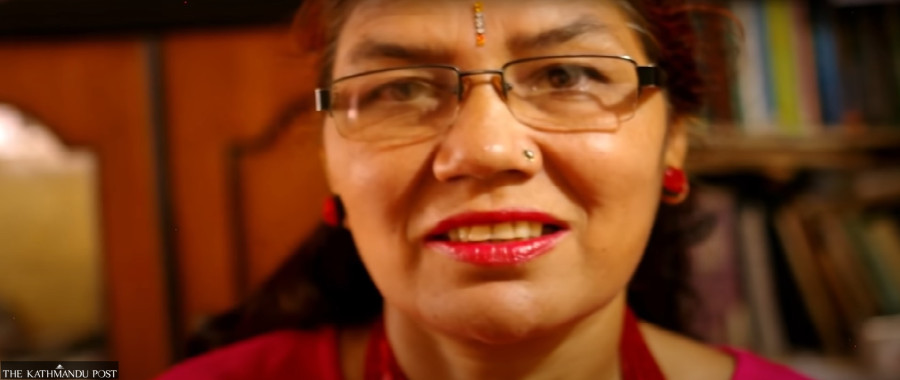Culture & Lifestyle
Poetry you can watch
The influence of poetry in visual arts is not a new phenomenon and seems to be growing every day.
Shuvangi Khadka
It is true poetry is everywhere!
From fiction to nonfiction, poetry is defying a single genre. From literature to art, poetry is defying a single form. Poetry’s malleability is even more apparent when words are fused with visual images to bring poetry to life in a new way.
The influence of poetry in visual arts is not a new phenomenon and seems to be growing every day. On YouTube, a long list of homemade minimalist poetry videos is piling. Numerous international poetry video festivals that celebrate poetic films are happening across the globe. One example is the Button Poetry video contest. On its playlist of the 2018 video contest, you even see an honourable mention of Nepali poet Rupesh Bhattarai with his poem titled ‘A Passport for My Mother’.
The video starts with his mother putting on her makeup as she prepares for a journey Bhattarai wishes to send her on.
“I didn’t want to film the video literally as per its wordings because I think the images should not be redundant,” Bhattarai shares. “I always had these vivid memories from my childhood of my mother putting on elaborate makeup before going out. I related this with how lead women actors were introduced in classic Bollywood films by focusing on their beauty. I wanted to draw a parallel there.”
Bhattarai always had an interest in making visuals for better storytelling. His social media handles are decorated with short still shots with his poetry as a voiceover. However, he admits he has not quite done what he aspires to do someday. “Right now, sometimes the video relates with the poem, and sometimes it doesn’t. But most of the time, video is like a cluttered anthology of its own and poetry is on its own. I want to build that connection eventually so that they will be in sync.”
Until now, he hasn’t written thinking solely for a poetry film. He does feel that writing with visuals in mind can be a metric way of thinking, a skill one has to build.
The same realisation dawned on me a few months ago when I attended an online workshop conducted by poet Jessica Abughattas on writing for or finding possibilities of cinematic poetry. Abughattas, who has been making such poetry videos herself, says, “Films work by juxtaposing uninflected images in a series of cuts. The binding agents of context and narrative take place in the subconscious minds of the audience. The same is true in poetry. Even without dialogue or explanation, we make sense of what a poem means through the juxtaposition of its images, a tension that needs resolving.”
Throughout the workshop, poems were broken down considering filmmaking techniques like how can a line be treated as a unit of measurement like a camera shot, a stanza like a scene and line breaks as cuts or transitions. Participants were asked to not write what they felt but externalise emotions as specific visuals.
Across regions, different terminologies are used for this expression. A Pakistani filmmaker Ayesha Raees, who wrote her thesis on video poetry, calls them video poems. YouTube creator Ramuna Pun is lauded for her melancholic visual poetry. It differs depending on what a poet or filmmaker is trying to create.
Filmmakers Ganga Sagar Rai and Shradha Khadka from the Kausee Productions elaborate it further. “For me, visual poetry is like a montage of random visuals with poetry while cinematic poetry has a story and a narrative arc which follows the main character. Like movies, we are telling a story from that video,” says Rai.
After watching a French filmmaker’s similar work, The Kausee Productions initiated their storytelling journey through cinematic poetry with a low budget and minimalist approach. Like how the French New wave filmmakers did, The Kausee Productions team used handheld cameras to shoot on location, partly out of practicality and partly out of innovation. This allowed for cheap and quick shoots, giving a less static and structured feel.
Rai and Khadka confess their lack of good technical skills in filmmaking but also assure that their desire for storytelling more than make up for it.
However, as poetry doesn’t usually have a linear narrative, it can be difficult to streamline a story. “Poetry can lend a narrative to itself without telling a story bit by bit,” say director-duo Saad Nawab and Varsha Panikar of short poetic film ‘Bodies of Desire’ in their interview when the film was showcased as part of British Council’s 2021 program of Five Films for Freedom.
Using Panikar’s poetry series of the same name as the point of departure, ‘Bodies of Desire’ is a visual poetry film co-directed by Panikar and Saad Nawab. The film celebrates genderless love and creates a portrait of tender intimacy in a montage-like structure.
But doesn’t storytelling through the use of poetry run the risk of being too abstract?
“Personally, I can’t relate to a poem that is too abstract. While making our cinematic poetry ‘Aja Kun Din?’ I asked Shradha to re-write the poem three times. Abstract expressions are innate to human nature but everyone might not understand it,” says Rai.
The abstract idea exists in both poetry and films. Their combination may exaggerate vagueness in poetry films. But if finely tuned, they can also intensify the whole meaning.
Poetry films are however not limited to short videos. One of the current feature filmmakers Terrence Malick is known for his quest for ‘poetic cinema’. His 2011 Palme d'Or winning film ‘The Tree of Life’ throws the traditional linear structure out of the window and experiments with a new way of visual storytelling.
The movie is not only poetic in the visual sense, but also in its narrative style. The movie breaks away from the dialogue constructed drama. The movie combines an epic sea of juxtaposing striking images of dinosaurs, births, and big bang cosmology with poetic whispers of characters. Therefore, it is not considered a big Hollywood film, but a piece of poetry on the screen.
While trying to find its actual script, I stumbled upon its abridged script on the internet where half of the people trashed the movie while the other half confessed that the movie emotionally wrecked them. The abstract nature of the poetic film does make it difficult for a person to understand a story completely. But I agree with someone from the comments section who wrote “You don’t read fiction books the same way you read poetry right?”
In his other films as well, Terrence Malick tries to capture life as he sees it, in fragments and memories. He wants to show everyone how the world and life unfold before him. Poetry seems to be the only answer for him.
Poetry as a form of truth-seeking allows films to remain raw and seek truths of life. Maybe this helps give a new dimension to storytelling but also talk more about realities of life in their raw form without the conventional forms of storytelling infused with drama.
As Rai says, “Cinematic poetry doesn’t just have to be an independent genre but every filmmaker can see it as a tool to use in whichever films they make.”
The growing need to imbibe poetry in different genres leads me back to an age-old debate about whether poetry in the traditional sense is becoming obsolete. When I ask Bhattarai the same, he disagrees strongly and says, “I think having poetry across different genres means it is only being more universal and not obsolete.” Rai and Khadka too believe that poetry isn’t dying but living different lives.




 22.65°C Kathmandu
22.65°C Kathmandu















